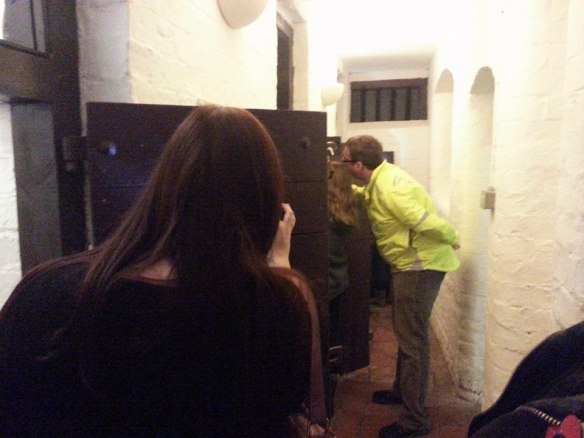When old buildings at the back of the Bolton Warehouse Company’s shop on Bird St (1) were being demolished in December 1960, a large circular room containing murals created with shells and pebbles, was found above a ceiling. One mural depicted the Cathedral, another a tree and the third was some kind of summerhouse on top of a hill (2).
The murals are thought to have been created by French prisoners of war, on parole in the city. According to the County History, Lichfield had long been used as a place to quarter French prisoners, due to its position on a main road (and I have also read that it had something to do with us being about as far from the sea as you can get!). On 7th January 1747, the Staffordshire Advertiser reported that a party of seventy four passed through Stafford on their way to Lichfield, where they were to be put on parole. It also mentioned a house on Bore St, where there was a cooper’s shop at the back used by prisoners (3). Eighty arrived in Lichfield in 1797 during the Napolenic Wars and in 1809, forty officers were quartered here. It seems that Dr Johnson’s birthplace was also occupied by a prisoner – in The European Magazine for 1810, a contributor called ‘TSW’ wrote, “The house in the market place in which our great lexicographer born still remains nearly in its original state. It is now inhabited by Mr Evans a brazier and a part of it, believed to be the very room in which he first drew his breath is now let to a French prisoner of war”. According to their website, Pipe Hill House on the Walsall Rd also hosted some of the prisoners.
As well as spending their time creating enigmatic artworks, some of the prisoners gave French lessons to the city’s residents. If the fragment of a page of French exercises, found in the same room as the Bird St mural was discovered, is anything to go by, the teachers had their work cut out. The sentences on the fragment of paper had been heavily corrected, with the comment ‘very bad’ at the end! Perhaps the Darwin and Wedgewood children who were taught French by one of the prisoners at Darwin’s house on Beacon St were better students?

The old clinic on Sandford St? Is it me or can anyone else see numbers in the brick work on the second storey?
In September 1951, the author of the ‘Round and About with Clock Tower” section of the Lichfield Mercury visited the site of the mural accompanied by the caretaker, Mrs Disney, and reported that the ‘pictures’ were still in existence in the dome-like roof of a derelict outbuilding behind the Sandford St Clinic (4). One side featured ‘a perfect replica of Lichfield Cathedral, made entirely from small stones, bits of glass and sea shells’ and other pictures included a ‘mosque-like building’, (which the reporter failed to recognise (5)), several ‘beautifully executed trees’ and a map of Lichfield. The outbuilding was in a poor condition, described as being encased in a mass of creepers, with two gaping holes in the roof. There was also a large hole in the floor, and as if things weren’t exciting enough already, Mrs Disney told the reporter that there were two passages running beneath the hole – one leading to the rear of the property and one believed to connect with the old ‘monk’s passages’ beneath the Friary.

Box made by French Prisoners of War (c) Lichfield District Council
Sadly, I think that this ‘Disney’ story doesn’t have a happy ending as the outbuilding was been demolished and the treasures inside lost (although there is the possibility that as the murals were still in existence in the 1950s/1960s someone may have been foresighted enough to photograph them?). However, there is a small consolation at Lichfield Heritage Centre in the form of a wooden box carved by French prisoners quartered in the area.
Edit 18/6/2015
A display at Lichfield Museum at St Mary’s features a photograph and a chunk of the mural together with the wooden box and some information about the soldiers themselves. St Mary’s is also staging a costume drama called ‘Lichfield’s Waterloo’ by the Lichfield Players on Friday 26th June and Saturday 27th June. More information here
Notes
(1) Does anyone have anymore information on the Bolton Warehouse Company’s shop, particularly where it was on Bird St?
(2) Could this have been a representation of Borrowcop Gazebo? The PMSA record (here) says ‘In 1694 a building called ‘the Temple’, probably stood on Borrow Cop Hill, in the 1720s an arbour was recorded, by 1750 this replaced by a summerhouse which may have been the cruciform building there in 1776. In 1756 the corporation ordered a line of trees along the path to the summit, with extra trees in 1783, possibly in connection with a fete champetre held in that year. By 1805 the building was replaced with one of brick with two arches each side and seats around to admire the view, the funds were raised by public subscription’. On the subject of Borrowcop, I just found at that an information board was installed up there in September (more about that here).
(3) Again, where would this have been?
(4) I understand that the clinic occupied the former premises of the Victoria Nursing Home which was on Sandford St until it moved to the Friary and became the Victoria Hospital.
(5) Any ideas as to what building this could be depicting?
Sources
Lichfield and Archaeological & Historical Society Transactions vol 2 1961
Lichfield: Education’, A History of the County of Stafford: Volume 14: Lichfield (1990), pp. 170-184
Lichfield: From the Reformation to c.1800′, A History of the County of Stafford: Volume 14: Lichfield (1990), pp. 14-24
The European Magazine for 1810
Lichfield Mercury 21st September 1951






























